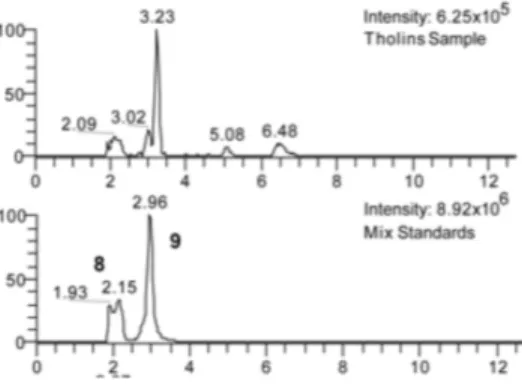HAL Id: insu-01208003
https://hal-insu.archives-ouvertes.fr/insu-01208003
Submitted on 1 Oct 2015
HAL is a multi-disciplinary open access
archive for the deposit and dissemination of
sci-entific research documents, whether they are
pub-lished or not. The documents may come from
teaching and research institutions in France or
abroad, or from public or private research centers.
L’archive ouverte pluridisciplinaire HAL, est
destinée au dépôt et à la diffusion de documents
scientifiques de niveau recherche, publiés ou non,
émanant des établissements d’enseignement et de
recherche français ou étrangers, des laboratoires
publics ou privés.
HPLC-Orbitrap analysis for identification of organic
molecules in complex material
Thomas Gautier, Isabelle Schmitz-Afonso, Nathalie Carrasco, D. Touboul,
Cyril Szopa, Arnaud Buch, Pascal Pernot
To cite this version:
Thomas Gautier, Isabelle Schmitz-Afonso, Nathalie Carrasco, D. Touboul, Cyril Szopa, et al..
HPLC-Orbitrap analysis for identification of organic molecules in complex material. European planetary
science congress (EPSC), Sep 2015, Nantes, France. pp.801-802. �insu-01208003�
HPLC-Orbitrap analysis for identification of organic
molecules in complex material
T. Gautier (1,2), I. Schmitz-Afonso (3,4), N. Carrasco (2,5), D. Touboul (3), C. Szopa (2), A. Buch (6) and P. Pernot (7). (1) NASA Postdoctoral program at Goddard Space Flight Center, Greenbelt, USA, (2) Université de Versailles St Quentin, LATMOS, Guyancourt, France, (3) ICSN, CNRS, Gif-sur-Yvette, France, (4) COBRA, Université de Rouen, INSA de Rouen, CNRS, IRCOF, Mont-Saint-Aignan, France, (5) Institut Universitaire de France, Paris, France, (6) LGPM, Ecole Centrale de Paris, Chatenay-Malabry, France (7) LCP, Universitée Paris-Sud 11, Orsay, France (Thomas.j.gautier@nasa.gov)
Abstract
We performed High Performance Liquid Chromatography (HPLC) coupled to Orbitrap High Resolution Mass Spectrometry (OHR MS) analysis of Titan’s tholins. This analysis allowed us to determine the exact composition and structure of some of the major components of tholins.
1. Introduction
Influx of solar photons and heavy charged particles from Saturn’s magnetosphere on Titan’s atmosphere - mainly comprised of methane and nitrogen - induce an intense organic photochemistry, which leads to the formation of a large amount of aerosols in suspension in the atmosphere [1]. The exact composition of these aerosols still remains unknown. A fruitful proxy to investigate these aerosols is the use of laboratory experiments that allow producing and studying laboratory analogs of Titan aerosol, so called tholins. We propose here an analysis of tholins with HPLC-OHRMS to unveil the isomeric ambiguity on some of the major compounds among the ~15,000 molecular peaks detected in tholins by high resolution mass spectrometry [3].
2. Methods
Tholins analyzed were produced with the PAMPRE [2] experimental platform at LATMOS, France, and prepared following the protocol detailed in Gautier et al. 2014 [3]. For strict identification of the compounds, chromatograms of tholins were compared to those of high purity standards corresponding to the possible isomers of the most intense molecules detected in tholins OHR mass spectrum [3].
Both tholins and standard compounds were analyzed by HPLC-OHRMS. HPLC was performed on a HPLC Ultimate 3000 system (Dionex) coupled with a LTQ-Orbitrap (ThermoScientific) equipped with an Electrospray Ionization Source (ESI). Analyses were performed in positive ionization mode. We tested three different chromatographic columns to get complimentary separation on the compounds tested (octadecyl, cyano and aminopropyl columns).
3. Results
We tested 13 different standard compounds reprensenting possible isomeric composition of 8 of the major molecules detected within tholins using OHRMS. Figure 1 presents a typical chromatogram for a comparison between our tholins sample with a mix of standard at m/z 84.056 on the aminopropyl column.
Figure 1: Comparative chromatogram at m/z 84.056 of tholins (top) and a mix of 3-aminopyrazole and 1-methyl-1,2,4-triazole.
EPSC Abstracts
Vol. 10, EPSC2015-801, 2015
European Planetary Science Congress 2015
c
Among the compounds tested we were able to strictly identify 6 compounds to be present in tholins. We also determined that 5 of the compounds tested were not present in significant amount, including Hexamethylenetetramine.
All the compounds confirmed has a high content in nitrogen with a ratio N/C comprised between 1.25 and 2, and most of these compounds include heterocycles.
4. Conclusion
Even though N-bearing compounds do not form the entire material (some pure hydrocarbon compounds are detected by OHRMS), it is clear that N-bearing aromatics constitute a significant part of tholins material.
Our work also confirms the importance of having chromatographic separation in the case of such complex material comprising thousands of different molecules, such as Titan tholins, to identify the structure of the molecules detected by OHR-MS. We also point out that, at the very least, two columns are needed to identify compounds due to the high number of possible isomers for a given molecular peak detected in high resolution mass spectrometry.
References
[1] Waite, J. H., D. T. Young, T. E. Cravens, A. J. Coates, F. J. Crary, B. Magee and J. Westlake: The Process of Tholin Formation in Titan's Upper Atmosphere." Science 316(5826), pp. 870-875, 2007.
[2] Szopa, C., G. Cernogora, L. Boufendi, J. J. Correia and P. Coll: PAMPRE: A dusty plasma experiment for Titan's tholins production and study. Planetary and Space Science 54(4): pp. 394-404, 2006.
[3] Gautier, T., N. Carrasco, I. Schmitz-Afonso, D. Touboul, C. Szopa, A. Buch and P. Pernot: Nitrogen incorporation in Titan's tholins inferred by high resolution orbitrap mass spectrometry and gas chromatography–mass spectrometry. Earth and Planetary Science Letters 404(0): pp. 33-42, 2014.
